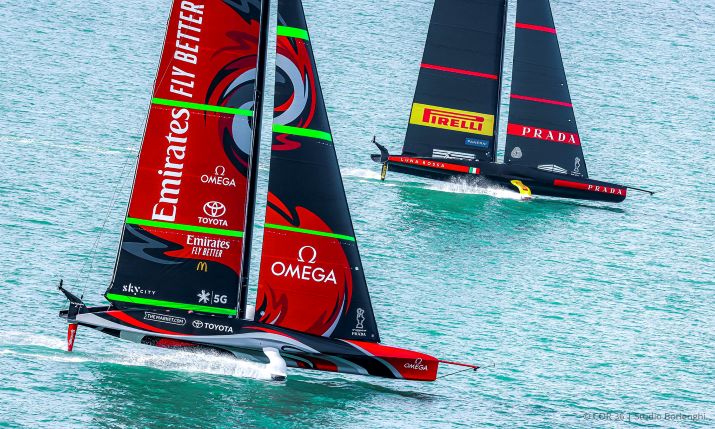‘A whole new level of coverage’: The America’s Cup plots a course to 1 billion viewers worldwide

When the 37th edition of the America’s Cup (AC37) sails off in October 2024 it will do so packed to the gunnels with sensors, mics and cameras in an effort to attract an audience of 1 billion viewers worldwide.
The world’s most prestigious yacht racing competition moves to Barcelona in 2024 for a challenger series beginning in August to decide which team will compete for the title against defending champions Emirates Team New Zealand.
Announced challengers include Alinghi Red Bull Racing from Switzerland, Luna Rossa Prada Pirelli from Italy, American Magic New York Yacht Club from the US and K-Challenge from France.
The 36th edition from Auckland was viewed by 942 million people worldwide. “We will look to beat that by a considerable margin at Barcelona 2024,” declares Stephen Nuttall, the event’s head of television. “We intend this to be the most watched America’s Cup of all time.”
Nuttall – a former senior director for YouTube in EMEA, and group commercial director of Sky – says that the race means to achieve this with technological innovation on the audiovisual side to match the high-tech design and engineering of the yacht’s carbon fibre hulls.
“Certainly, we’re intending to have more cameras than we’ve had in the past. We intend to produce UHD HDR coverage – something that has not been done before in sailing, let alone the America’s Cup. It will be surround sound. It will be a whole new level of coverage.”
As you might imagine, the technical challenges of covering the cup are considerable, starting with the fact that there can’t be any cables on the water, so every camera is wireless.
“We want to open up the experience of being on an America’s Cup yacht to the widest possible audience,” Nuttall explains. “That means more than 10 cameras, a plethora of sensors and 12 water-proof microphones on every boat and on the sailors so that viewers can feel what it’s like to be part of the crew.”
The onboards are complemented by two helicopters, each with a gyro-stabilised camera and two similarly equipped chase boat catamarans. At least one of the camera boats and all chase boats will use a hydrogen fuel cell for power.
F1 on water
“We’re looking at putting cameras and mics on the team chase boats to create an F1 pit lane-type experience but on water,” Nuttall reveals. “That hasn’t happened before.”
There’s a strong crossover between sailing and F1. Some teams, such as Alinghi and Ineos have established connections with Formula 1 teams – Red Bull Racing and Mercedes, respectively. Dan Bernasconi, lead designer for Team New Zealand, formerly worked at McLaren.
Nuttall says: “The America’s Cup puts the best engineers, designers and innovators each team can find to create the fastest possible boat within the designated design rules. It is the spearhead for cutting-edge innovation across industries. The same principles apply for the ACTV team, it is never a case of doing what has been done before with the TV coverage, but innovating and creating new frontiers of broadcast technology.”
“Certainly, we’re intending to have more cameras than we’ve had in the past. We intend to produce UHD HDR coverage – something that has not been done before in sailing”
The media team will deploy cameras and sensors not just to televise the event but to officiate the competition accurately. If a yacht strays outside the boundary or gets too close to, or in the way of, its competitor, a penalty is applied that may determine the outcome of the race or indeed the entire contest.
“We have to do this on a grand scale and with great complexity. An America’s Cup race takes place within an area 4km long and 1km wide, with multiple laps in each head-to-head encounter. We have a fixed time for each race to satisfy spectators and broadcasters, so we need to adjust the course to create the spectacle.”
With some campaigns costing over €100 million and with a history stretching back to 1851, these are high stakes: “We can’t afford to make a mistake,” he adds. “The America’s Cup is a 172-year-old start-up. Every time there’s a new winner of the trophy, this creates an opportunity to reset the rules of the game.”
Data in six dimensions
For AC37, the fundamentals of the yachts are the same, but the crew is reduced from 11 to 8. The new AC75 style yacht is an extreme, high-performance boat class that is 25m long and ‘flies’ on foils above the water at up to 100km/h – four times the speed of the wind.
“Nothing is fixed, yet we have to measure the boat in six dimensions: its x, y and z planes and the dynamics of roll, pitch and yaw to 100th of a degree, and calculate how far in millimetres the boats are above that ever-moving fluid surface,” he says.
“We also track the position of each boat and each of the objects on the racecourse in real time. You can imagine, with the size that the boats are, that a very small pitch forwards magnifies up to a massive movement at the top of the mast which is eight storeys high. So, it’s really important when you think about umpiring purposes and for the TV graphics that we measure everything very accurately. It is a phenomenal challenge.”
This generates 125 million data points a day. “If you’re a hardcore fan of sailing you can visit our website and build your own dashboard to follow the race in the way you want to follow it,” he adds. “A more casual viewer of sailing will be delighted by the world feed.”

At the 36th America’s Cup, the Luna Rossa and Te Rehutai battle it out
He continues: “The America’s Cup, uniquely, is a sailing event that transcends sailing. That is our dual challenge. It means we have to think about getting coverage on as many screens as possible, including on free-to-air networks, on our YouTube channel and website. We had 55 broadcast partners last time that covered 190 countries, and record numbers of TV viewers, but it was the online audience that grew the TV audience by 19%. Online is very material growth and a key to the event being open and accessible.”
Content is already being generated in the run up to the event. Media ‘Recon’ teams are embedded with each challenger and the Defender as they prepare for the cup in their home locations before arriving in Barcelona.
“There’s an almost daily update that goes out on social media telling fans of sailing what is happening, what the teams are experimenting with in the design of their boat, what training the teams are doing. It’s enabled us to have content all through the cycle as opposed to just the peak,” says Nuttall.
Mission Impossible documentary
A Netflix-style behind-the-scenes documentary series will further aim to energise audience interest. Currently in the early stages of production, the new series has some heavyweight names attached. It is being produced by Skydance, the film studio behind Top Gun: Maverick and the Mission: Impossible series, and produced and directed by an Oscar and Emmy Award winning team led by Jimmy Chin and Elizabeth Chai Varsaheyli, whose previous credits include Free Solo and The Rescue. The show’s co-producers also produced The Last Dance, ESPN 30 for 30 and The Redeem Team.
“Free Solo is a good example of what we want to do with the documentary series for the cup because it’s a climbing film that’s not about climbing,” says Nuttall. “It’s about one man’s struggle to fufill a life-long ambition. That is very relatable to the America’s Cup. The series will tell how the 100 people in each team devote four years to try to win probably the hardest to win trophy in all sport.”
Nuttall is in the process of working through tenders for provision of all onboard media equipment. In weight terms this equates to 135kg of media kit for each of the six competitor boats.
For the onshore outside broadcast operation, the team is again talking to various parties, including “local businesses, international businesses, world-class operations, and we’ll make some announcements about that soon”.
Nuttall was speaking at ISE, a trade event for the AV and systems integration industry, which is hosted at the Fira in Barcelona.
The city will become the first in the world to host both an Olympic Games and an America’s Cup event.

